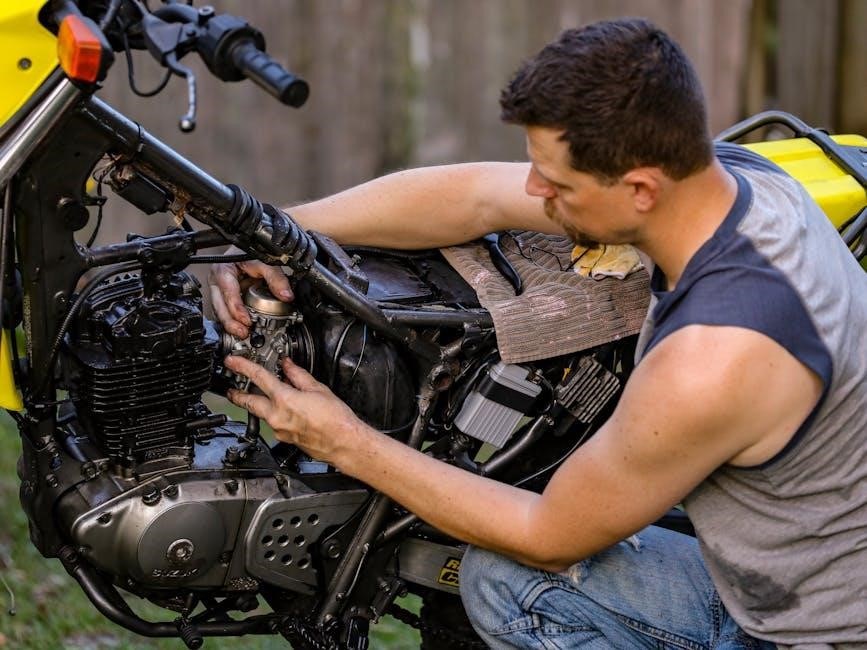small engine repair manual free download
Small engines power essential tools like lawn mowers and generators. Repairing them requires knowledge, tools, and manuals. Free manuals online guide DIY fixes, saving time and money.
1.1 Importance of Small Engine Repair
Small engine repair is crucial for maintaining reliability and performance in equipment like lawn mowers, generators, and chainsaws. Regular maintenance ensures longevity, reduces operational costs, and prevents sudden breakdowns. Access to free repair manuals empowers users to diagnose and fix issues independently, saving time and money. Proper repair practices also minimize environmental impact by reducing waste and emissions. Understanding small engine mechanics fosters self-sufficiency and confidence in handling repairs. Additionally, it enables users to troubleshoot common problems, optimizing efficiency and safety. Free manuals provide comprehensive guidance, making small engine repair accessible to everyone, regardless of expertise level. This accessibility promotes sustainability and resourcefulness in equipment maintenance.
1.2 Types of Small Engines
Small engines vary in design and application, with common types including 2-stroke and 4-stroke internal combustion engines. These engines power equipment like lawn mowers, generators, and handheld tools. 2-stroke engines are lightweight and simple, ideal for portable devices, while 4-stroke engines offer better fuel efficiency and are often used in larger equipment. Additionally, there are electric and propane-powered small engines, catering to eco-friendly and specialized needs. Free repair manuals cover these types, providing detailed specifications and maintenance tips. Understanding the differences helps in selecting the right engine for specific tasks and ensures proper repair and maintenance practices. This variety underscores the versatility of small engines in various applications.
1.3 DIY vs. Professional Repair
DIY small engine repair offers cost savings and hands-on learning, especially with free manuals guiding through basic fixes like carburetor cleaning or spark plug replacement. However, complex issues require professional expertise, ensuring safety and proper outcomes. DIY is suitable for minor tasks, while professionals handle major overhauls or specialized diagnoses. Free manuals empower DIYers but also highlight when professional intervention is necessary. Balancing these approaches ensures efficient and safe engine maintenance, leveraging resources like free manuals for initial troubleshooting before seeking expert help for intricate problems, thus optimizing both time and resources effectively in the repair process.

Safety Precautions in Small Engine Repair
Safety is crucial in small engine repair. Always handle fuel carefully, avoid sparks, and use protective gear. Ensure proper ventilation and follow manual guidelines strictly.
2.1 Handling Fuel and Chemicals
Handling fuel and chemicals in small engine repair requires extreme caution. Always wear protective gloves and eyewear to prevent skin and eye irritation. Use approved containers for storing and transferring fuel to avoid spills and leaks. Ensure the workspace is well-ventilated to prevent inhaling harmful fumes. Keep ignition sources, such as open flames or sparks, away from fuel-handling areas. Properly dispose of rags and materials soaked with fuel or chemicals to reduce fire risks. Refer to the repair manual for specific safety guidelines related to your engine’s fuel system. Never mix different types of fuel or chemicals, as this can create hazardous reactions.
2.2 Electrical System Safety
When working on small engine electrical systems, disconnect the battery first to prevent accidental starts. Avoid touching live wires or components to prevent shocks. Use a multimeter to test for voltage before handling electrical parts. Keep the workspace dry and avoid using damaged cords or tools. Never bypass safety features like fuses or circuit breakers. Properly ground the engine and ensure all connections are secure. Follow the repair manual’s guidelines for electrical system repairs. Always use insulated tools and wear protective gear. If unsure, consult a professional to avoid risks of electrical fires or injuries.
2.3 Protective Gear and Workspace Setup
Wear safety glasses, gloves, and a face mask when working with small engines to protect against debris and chemicals. Ensure the workspace is well-ventilated to avoid inhaling fumes. Use a sturdy workbench and secure the engine to prevent movement. Keep flammable materials away and have a fire extinguisher nearby. Organize tools within easy reach to minimize distractions. Disconnect the battery and ensure the engine is cool before starting repairs. Proper lighting is essential for visibility. Follow the repair manual’s safety guidelines to create a safe and efficient workspace. A clean, organized area reduces accidents and improves repair outcomes.

Tools and Equipment for Small Engine Repair
Essential tools include screwdrivers, wrenches, pliers, and a compression tester. Diagnostic tools like multimeters help troubleshoot issues. Organize tools neatly and refer to free manuals for specific needs.
3.1 Essential Tools for Small Engine Maintenance
Essential tools for small engine maintenance include screwdrivers, wrenches, pliers, and a compression tester. These tools help diagnose and fix common issues. Free manuals guide tool usage, ensuring proper repairs. Organization is key for efficiency. Additional items like spark testers and carburetor cleaners are also vital. Referencing free manuals online provides specific tool recommendations for your engine model, saving time and money. Proper tool selection ensures effective troubleshooting and prevents further damage. Always organize tools neatly and follow manual instructions for optimal results. Efficient tool use enhances repair success and extends engine lifespan. Free manuals offer detailed lists of necessary tools for various tasks, aiding DIY enthusiasts. Using the right tools ensures safety and effectiveness in repairs. Free resources help maintain your engine efficiently, reducing reliance on professional services. Regular tool maintenance also supports long-term engine health. Organized tool storage prevents loss and saves time during repairs. Free manuals often include tool checklists, making preparation easier. Proper tool usage is critical for successful small engine maintenance and repair. Free guides enhance your toolkit’s effectiveness, ensuring your engine runs smoothly. By following manual recommendations, you can maintain your tools and engine effectively, minimizing downtime and costs. Always refer to free manuals for specific tool requirements, optimizing your repair process. This approach ensures you have everything needed for efficient and successful small engine maintenance.
3.2 Diagnostic Tools for Troubleshooting
Diagnostic tools like multimeters, compression testers, and spark testers are crucial for troubleshooting small engines. Multimeters measure electrical systems, ensuring proper voltage and resistance. Compression testers identify issues like low compression, indicating piston or head problems. Spark testers verify ignition systems, ensuring sparks are present and strong. Free manuals often include diagnostic guides, helping users identify symptoms and locate faults. These tools enable precise troubleshooting, saving time and reducing guesswork. Regular use of diagnostic tools extends engine lifespan by catching issues early; Free manuals provide step-by-step instructions, making complex diagnostics accessible. With these tools, enthusiasts can efficiently pinpoint and resolve engine problems, ensuring optimal performance and reliability.
3.3 Organization and Storage of Tools
Organizing and storing tools properly is essential for efficient small engine repair. A clean, dedicated workspace with a toolbox or chest helps keep tools accessible and prevents loss. Use dividers or compartments to categorize tools by type or size. Labeling each section ensures quick retrieval. Free repair manuals often include tips on tool organization, emphasizing the importance of a structured workspace. Regularly cleaning and maintaining tools prevents rust and damage. Store tools in a dry, cool environment to preserve their condition. Proper organization enhances productivity, reduces frustration, and extends tool lifespan, making DIY repairs more manageable and enjoyable. A well-organized setup is key to successful repairs.

Common Small Engine Repairs
Common small engine repairs include carburetor cleaning, spark plug replacement, and air filter maintenance. These fixes are often detailed in free repair manuals, aiding DIY enthusiasts effectively.
4.1 Carburetor Cleaning and Adjustment
Carburetor cleaning and adjustment are critical for maintaining small engine performance. Dirt and debris often clog carburetors, leading to poor engine operation. Free repair manuals provide step-by-step guidance for disassembling, cleaning, and reassembling carburetors. Adjusting the air-fuel mixture ensures proper combustion. Manuals detail how to use carburetor cleaning solutions and compressed air for effective maintenance. Regular cleaning prevents fuel system issues and restores engine efficiency. DIY enthusiasts can follow these guides to troubleshoot and fix common carburetor problems, saving money on professional services. Proper adjustment techniques are also outlined, ensuring optimal engine function and longevity. These resources are invaluable for small engine repair.
4.2 Spark Plug Replacement and Maintenance
Spark plug replacement is a routine yet crucial task in small engine repair. Faulty spark plugs can cause misfires, reduced performance, and increased fuel consumption. Free repair manuals detail the process, emphasizing the importance of using a spark tester and gap gauge. Proper gapping ensures efficient combustion, while cleaning or replacing worn-out plugs restores engine power. Manuals often include diagrams for locating spark plugs and step-by-step instructions for removal and installation. Regular maintenance prevents engine damage and ensures reliable operation. DIYers can follow these guides to identify and address spark plug issues, ensuring optimal engine function and longevity. This simple task can significantly improve performance.

4.3 Air Filter Cleaning and Replacement
Air filters are vital for small engine performance, ensuring clean air intake and protecting the engine from debris. Free repair manuals provide detailed steps for cleaning or replacing air filters. Regular inspection is crucial, as a dirty filter can reduce power, efficiency, and cause overheating. Manuals often include diagrams showing filter locations and maintenance schedules. Cleaning foam or paper filters is common, while some may require replacement. Proper reinstallation ensures the engine runs smoothly. Neglecting air filter maintenance can lead to poor performance and potential engine damage. DIYers can follow these guides to keep their engines running optimally and extend their lifespan.

Troubleshooting Small Engine Issues
Troubleshooting small engine issues involves identifying common symptoms, performing compression tests, and checking the fuel system. Free manuals provide detailed diagnostic steps and solutions.
5.1 Identifying Common Symptoms
Identifying common symptoms is crucial for effective troubleshooting. Engines may show issues like poor starting, rough running, or overheating. Free repair manuals detail these symptoms, aiding diagnosis. They outline typical problems and solutions, helping users pinpoint issues quickly. Manuals also cover error codes and unusual noises, providing a comprehensive guide for DIY repairs. By referencing these resources, individuals can address problems efficiently, ensuring their equipment runs smoothly. Regular symptom checks prevent minor issues from escalating, saving time and money. Free manuals are invaluable for maintaining and repairing small engines effectively.
5.2 Compression Test and Leak Detection
A compression test is essential for diagnosing engine health. Low compression indicates issues like worn piston rings or head gaskets. Free repair manuals guide users through the process, explaining how to use a compression tester. Similarly, leak detection involves checking for cracks or loose connections. Manuals often suggest using a soapy water solution to identify air leaks in intake systems. These tests help pinpoint internal and external damage. By following manual instructions, individuals can perform accurate diagnoses, ensuring repairs are effective. Regular testing prevents engine failure, keeping small engines running efficiently and extending their lifespan. These procedures are vital for maintaining optimal performance and reliability.
5.3 Diagnosing Fuel System Problems
Fuel system issues are common in small engines, often causing poor performance or failure to start. Free repair manuals provide detailed steps to diagnose such problems. Begin by checking for clogged fuel lines or a faulty carburetor. Ensure the fuel filter is clean and the tank is vented properly. If the engine stalls or runs rough, inspect the fuel pump or injector for malfunction. Manuals often recommend using a multimeter to test electrical connections in fuel-related components. Addressing these issues promptly prevents further damage and ensures reliable engine operation. Regular maintenance, as outlined in repair guides, helps avoid fuel system complications altogether.

Small Engine Repair Manuals
Free small engine repair manuals are widely available online, offering detailed instructions for DIY fixes. Websites like Autozone provide access to these resources, aiding enthusiasts and professionals alike.
6.1 What to Look for in a Repair Manual
When searching for a small engine repair manual, ensure it includes detailed diagrams, step-by-step instructions, and specific information about your engine model. Compatibility with your engine’s make and model is crucial for accurate repairs. Look for manuals that cover troubleshooting, maintenance, and common repairs. Many free manuals, such as those from Autozone, offer comprehensive guides tailored to specific engines. Verify the manual’s publication date and relevance to your engine’s year and type. Clear terminology and organized sections are essential for effective DIY repairs. Always cross-check the manual’s content with your engine’s specifications to ensure reliability and safety during repairs.
6.2 Sources for Free Small Engine Repair Manuals
Several websites offer free small engine repair manuals, such as Autozone, which provides comprehensive guides for various engine models. Manufacturer websites often include official manuals for specific engines, ensuring accuracy. Online forums and communities, like JustAnswer, frequently share manuals or direct links to download them. Additionally, platforms like ManualsLib and Scribd host a wide range of repair manuals. When searching, use specific terms like the engine model, type, and code to find relevant manuals. These resources are invaluable for DIY repairs, covering troubleshooting, maintenance, and detailed repair procedures. Always verify the source’s reliability to ensure the manual’s accuracy and safety.
6.3 Comparing Free vs. Paid Manuals
Free small engine repair manuals are ideal for basic repairs and DIY enthusiasts, offering essential information for common issues. However, paid manuals provide detailed, comprehensive guides tailored to specific engine models, making them invaluable for complex repairs. Free manuals often lack advanced troubleshooting and may not cover all engine types, while paid versions include official diagrams, specifications, and step-by-step instructions. For professionals or those tackling extensive overhauls, paid manuals are worth the investment due to their accuracy and completeness. Free options are cost-effective for minor fixes, but paid manuals ensure reliability and depth for critical repairs, balancing cost and quality based on user needs. Always choose the best fit for the task at hand to ensure successful outcomes.

Advanced Small Engine Repair Techniques
Advanced techniques involve engine overhauls, cylinder head resurfacing, and performance upgrades. Free manuals often provide foundational guidance, but detailed steps may require paid resources for precision and safety.
7.1 Engine Overhaul and Rebuilding
Engine overhauls involve dismantling, inspecting, and replacing worn components. Free repair manuals often outline basic procedures, but detailed rebuild guides may require paid resources. Ensure proper tools and workspace for precision. Clean and inspect parts thoroughly before reassembly. Replace piston rings, bearings, and gaskets as needed. Use torque specifications from manuals for critical bolts. Rebuilding requires patience and attention to detail to restore engine performance and longevity. Free manuals can provide foundational guidance, but for complex tasks, supplementing with specialized tools and resources is essential for a successful overhaul.
7.2 Cylinder Head Repair and Resurfacing
Cylinder head repair and resurfacing are critical for maintaining proper engine performance. Free repair manuals often provide detailed steps for diagnosing cracks, warping, or excessive wear. Resurfacing involves machining the head to restore a smooth surface, essential for proper sealing. Inspect for damaged studs, threads, or valves. Clean and assess the head before attempting repairs. Minor cracks may be repaired with specialized kits, while severe damage often requires professional machining. Free manuals can guide basic resurfacing techniques, but advanced tools may be needed for precision. Always follow manual instructions to ensure proper fitment and prevent further damage during reassembly.
7.3 Performance Enhancements and Upgrades
Performance enhancements for small engines can significantly boost power and efficiency. Free repair manuals often include DIY tips for upgrading components like air filters, mufflers, and carburetors. Porting and polishing the cylinder head can improve airflow, while aftermarket camshafts enhance combustion efficiency. Lightweight pistons and performance spark plugs are popular upgrades. Manuals may also guide engine timing adjustments for optimal performance. However, modifications should align with the engine’s intended use to avoid damage. Always consult the manual for compatibility and safety precautions to ensure upgrades are done correctly and safely, avoiding potential risks like overheating or reduced longevity. Proper tools and techniques are essential for success.

Legal and Ethical Considerations
Respect copyright laws when using free repair manuals. Ensure compliance with environmental regulations during repairs. Be mindful of warranty terms to avoid liability issues.
8.1 Copyright Laws and Manual Usage
When accessing free small engine repair manuals, ensure compliance with copyright laws. Many manuals are protected by copyright, and unauthorized distribution or use can lead to legal consequences. Always verify the source of the manual to avoid infringing on intellectual property rights. Some manufacturers provide free manuals for personal use, while others may require purchase or subscription. Respecting copyright ensures legal and ethical use of repair materials. Be cautious of unofficial sources that may violate copyright laws. Using copyrighted material without permission can result in penalties, so always opt for legally available resources or purchase manuals directly from the manufacturer or authorized dealers.
8.2 Environmental Impact of Repairs
Small engine repairs can have environmental implications. Proper disposal of hazardous materials like oil, fuel, and coolant is crucial to prevent contamination. Using eco-friendly alternatives and adhering to sustainable practices minimizes ecological harm. Repairing rather than replacing engines reduces waste and conserves resources. Following guidelines in repair manuals ensures environmentally responsible practices. Additionally, efficient repairs can lower emissions and improve fuel efficiency, benefiting the environment. Always dispose of waste responsibly and recycle parts when possible to minimize the ecological footprint of small engine maintenance. Eco-conscious repairs contribute to a greener future while maintaining engine performance. Free manuals often include tips for environmentally friendly practices, promoting sustainability.
8.3 Warranty and Liability Issues
When using free repair manuals for small engine repair, understanding warranty and liability is crucial. DIY repairs may void manufacturer warranties, leaving owners liable for further damages. Ensure compliance with warranty terms to avoid issues. Additionally, improper repairs can lead to legal consequences if equipment fails and causes harm. Always verify manual accuracy and follow safety guidelines to minimize liability risks. Consulting professionals for complex repairs can mitigate potential legal and financial repercussions. Be aware of local regulations regarding repairs and ensure all work meets safety standards to avoid liability concerns. Proper documentation of repairs can also provide legal protection if disputes arise. Stay informed to protect yourself and others. Free manuals can guide repairs but do not absolve users of liability. Use caution and seek professional help when unsure. Always prioritize safety to prevent legal issues. Free manuals are valuable resources but require responsible use. Keep detailed records of all repairs for accountability. This ensures transparency and reduces liability risks. Regular inspections after repairs can further safeguard against potential legal complications. By being mindful of warranty and liability, you can confidently perform repairs while protecting yourself legally. Free manuals empower DIYers but demand attention to these critical aspects. Stay vigilant to avoid legal pitfalls and ensure safe, effective repairs. Proper adherence to guidelines minimizes liability, allowing users to benefit from free manuals responsibly. Always consider warranty terms before starting any repair to prevent unintended consequences. Liability awareness is key to successful and stress-free small engine maintenance. Use free manuals wisely and stay informed about legal obligations. This approach ensures safe, efficient, and legally compliant repairs. Free resources are invaluable but require careful handling to avoid liability issues. By understanding and addressing warranty and liability concerns, users can maximize the benefits of free repair manuals. Always err on the side of caution to protect yourself and others. Free manuals offer guidance but require responsible application to prevent legal complications. Stay proactive in addressing warranty and liability matters for a hassle-free repair experience. Free resources empower users but demand accountability. Prioritize safety, follow guidelines, and remain aware of legal implications to ensure successful repairs. This balanced approach allows users to leverage free manuals effectively while minimizing risks. Liability and warranty considerations are essential for responsible small engine repair. Use free manuals with care to avoid legal challenges and ensure optimal results. By staying informed and cautious, users can confidently utilize free resources for successful repairs. Always consider the legal and financial implications of DIY repairs to protect yourself. Free manuals are tools for empowerment but require mindfulness of liability and warranty terms. Approach repairs with caution and responsibility to avoid legal issues. This ensures a positive experience while using free repair manuals. Liability and warranty awareness are vital for safe and effective small engine maintenance. Use free resources wisely to prevent legal complications and ensure successful outcomes. Always prioritize safety and legal compliance when using free repair manuals. This responsible approach protects users and maximizes the benefits of free resources. Stay informed about warranty and liability to avoid legal pitfalls and enjoy stress-free repairs. Free manuals are valuable but require careful handling to prevent legal issues. By understanding and addressing these concerns, users can confidently perform repairs. Always consider liability and warranty terms before starting any project. This ensures a safe and legally compliant repair process. Free manuals empower DIYers but demand attention to these critical aspects. Stay vigilant to avoid legal challenges and ensure successful repairs. Proper adherence to guidelines minimizes liability, allowing users to benefit from free manuals responsibly. Always consider warranty terms before starting any repair to prevent unintended consequences. Liability awareness is key to successful and stress-free small engine maintenance. Use free manuals wisely and stay informed about legal obligations. This approach ensures safe, efficient, and legally compliant repairs. Free resources are invaluable but require careful handling to avoid liability issues. By understanding and addressing warranty and liability concerns, users can maximize the benefits of free repair manuals. Always err on the side of caution to protect yourself and others. Free manuals offer guidance but require responsible application to prevent legal complications. Stay proactive in addressing warranty and liability matters for a hassle-free repair experience. Free resources empower users but demand accountability. Prioritize safety, follow guidelines, and remain aware of legal implications to ensure successful repairs. This balanced approach allows users to leverage free manuals effectively while minimizing risks. Liability and warranty considerations are essential for responsible small engine repair. Use free manuals with care to avoid legal challenges and ensure optimal results. By staying informed and cautious, users can confidently utilize free resources for successful repairs; Always consider the legal and financial implications of DIY repairs to protect yourself. Free manuals are tools for empowerment but require mindfulness of liability and warranty terms. Approach repairs with caution and responsibility to avoid legal issues. This ensures a positive experience while using free repair manuals. Liability and warranty awareness are vital for safe and effective small engine maintenance. Use free resources wisely to prevent legal complications and ensure successful outcomes. Always prioritize safety and legal compliance when using free repair manuals. This responsible approach protects users and maximizes the benefits of free resources; Stay informed about warranty and liability to avoid legal pitfalls and enjoy stress-free repairs. Free manuals are valuable but require careful handling to prevent legal issues. By understanding and addressing these concerns, users can confidently perform repairs. Always consider liability and warranty terms before starting any project. This ensures a safe and legally compliant repair process. Free manuals empower DIYers but demand attention to these critical aspects. Stay vigilant to avoid legal challenges and ensure successful repairs. Proper adherence to guidelines minimizes liability, allowing users to benefit from free manuals responsibly. Always consider warranty terms before starting any repair to prevent unintended consequences. Liability awareness is key to successful and stress-free small engine maintenance. Use free manuals wisely and stay informed about legal obligations. This approach ensures safe, efficient, and legally compliant repairs. Free resources are invaluable but require careful handling to avoid liability issues. By understanding and addressing warranty and liability concerns, users can maximize the benefits of free repair manuals. Always err on the side of caution to protect yourself and others. Free manuals offer guidance but require responsible application to prevent legal complications. Stay proactive in addressing warranty and liability matters for a hassle-free repair experience. Free resources empower users but demand accountability. Prioritize safety, follow guidelines, and remain aware of legal implications to ensure successful repairs. This balanced approach allows users to leverage free manuals effectively while minimizing risks. Liability and warranty considerations are essential for responsible small engine repair. Use free manuals with care to avoid legal challenges and ensure optimal results. By staying informed and cautious, users can confidently utilize free resources for successful repairs. Always consider the legal and financial implications of DIY repairs to protect yourself. Free manuals are tools for empowerment but require mindfulness of liability and warranty terms. Approach repairs with caution and responsibility to avoid legal issues. This ensures a positive experience while using free repair manuals. Liability and warranty awareness are vital for safe and effective small engine maintenance. Use free resources wisely to prevent legal complications and ensure successful outcomes. Always prioritize safety and legal compliance when using free repair manuals. This responsible approach protects users and maximizes the benefits of free resources. Stay informed about warranty and liability to avoid legal pitfalls and enjoy stress-free repairs. Free manuals are valuable but require careful handling to prevent legal issues. By understanding and addressing these concerns, users can confidently perform repairs. Always consider liability and warranty terms before starting any project. This ensures a safe and legally compliant repair process. Free manuals empower DIYers but demand attention to these critical aspects. Stay vigilant to avoid legal challenges and ensure successful repairs. Proper adherence to guidelines minimizes liability, allowing users to benefit from free manuals responsibly. Always consider warranty terms before starting any repair to prevent unintended consequences. Liability awareness is key to successful and stress-free small engine maintenance. Use free manuals wisely and stay informed about legal obligations. This approach ensures safe, efficient, and legally compliant repairs. Free resources are invaluable but require careful handling to avoid liability issues. By understanding and addressing warranty and liability concerns, users can maximize the benefits of free repair manuals. Always err on the side of caution to protect yourself and others. Free manuals offer guidance but require responsible application to prevent legal complications. Stay proactive in addressing warranty and liability matters for a hassle-free repair experience. Free resources empower users but demand accountability. Prioritize safety, follow guidelines, and remain aware of legal implications to ensure successful repairs. This balanced approach allows users to leverage free manuals effectively while minimizing risks. Liability and warranty considerations are essential for responsible small engine repair. Use free manuals with care to avoid legal challenges and ensure optimal results. By staying informed and cautious, users can confidently utilize free resources for successful repairs. Always consider the legal and financial implications of DIY repairs to protect yourself. Free manuals are tools for empowerment but require mindfulness of liability and warranty terms. Approach repairs with caution and responsibility to avoid legal issues. This ensures a positive experience while using free repair manuals. Liability and warranty awareness are vital for safe and effective small engine maintenance. Use free resources wisely to prevent legal complications and ensure successful outcomes. Always prioritize safety and legal compliance when using free repair manuals. This responsible approach protects users and maximizes the benefits of free resources
9.3 Hands-On Practice and Training

Additional Resources for Small Engine Repair
Explore online forums, local repair shops, and hands-on training for comprehensive small engine repair guidance. These resources complement free manuals, offering practical insights and expert advice.
